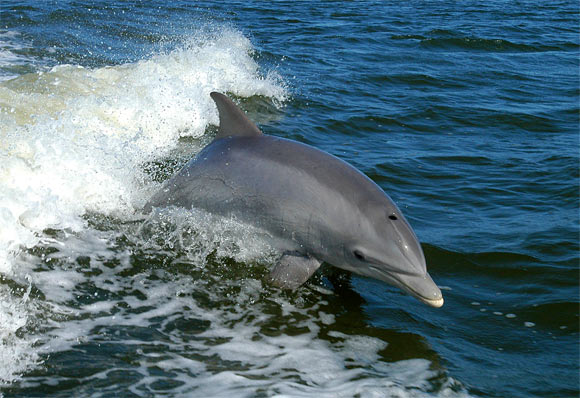High levels of BMAA (β-methylamino-L-alanine), a neurotoxin produced by cyanobacterial blooms, and beta-amyloid plaques, a hallmark in human beings of Alzheimer’s disease, have been detected in the brain tissues from dolphins stranded on the beaches of Florida and Massachusetts.

Davis et al detected BMAA in the cerebral cortex of stranded dolphins; they also report Alzheimer-like neurodegenerative changes in the brains of dolphins containing BMAA. Image credit: NASA.
“Dolphins are an excellent sentinel species for toxic exposures in the marine environment,” said senior author Dr. Deborah Mash, a researcher at the University of Miami.
“With increasing frequency and duration of cyanobacterial blooms in coastal waters, dolphins might provide early warning of toxic exposures that could impact human health.”
In the study, Dr. Mash and colleagues measured BMAA in a series of brains collected from dolphins stranded in Florida and Massachusetts.
A total of 14 dolphins were investigated from two species: the bottlenose dolphin (Turiops truncates) and the common dolphin (Delphinus delphis).
The researchers detected high levels of BMAA (20-748 μg/g) in the brains of 13 of the 14 dolphins (93%).
They also found Alzheimer-like neurodegenerative changes in the brains containing BMAA.
“We found beta-amyloid plaques and damaged neurons in brain tissues from dolphins that had died on the beaches of Florida and Massachusetts,” said study lead author Dr. David Davis, a neuropathologist at the University of Miami.
“We cannot say for sure that chronic exposure to cyanobacterial blooms can trigger Alzheimer’s in humans but it is a risk that I personally am unwilling to take,” said study co-author Dr. Larry Brand, an oceanographer at the University of Miami.
“The neuropathology and brain toxins in the dolphins are similar to those found in the brains of Chamorro villagers in Guam who suffered from an Alzheimer’s-like disease,” said study co-author Dr. Paul Alan Cox, an ethnobotanist at the Institute for Ethnomedicine.
“The question is whether these marine mammals experienced cognitive deficits and disorientation that led to their beaching.”
“Until further research clarifies this question, people should take simple steps to avoid cyanobacterial exposure.”
The study was published online in the journal PLoS ONE.
_____
D.A. Davis et al. 2019. Cyanobacterial neurotoxin BMAA and brain pathology in stranded dolphins. PLoS ONE 14(3): e0213346; doi: 10.1371/journal.pone.0213346







